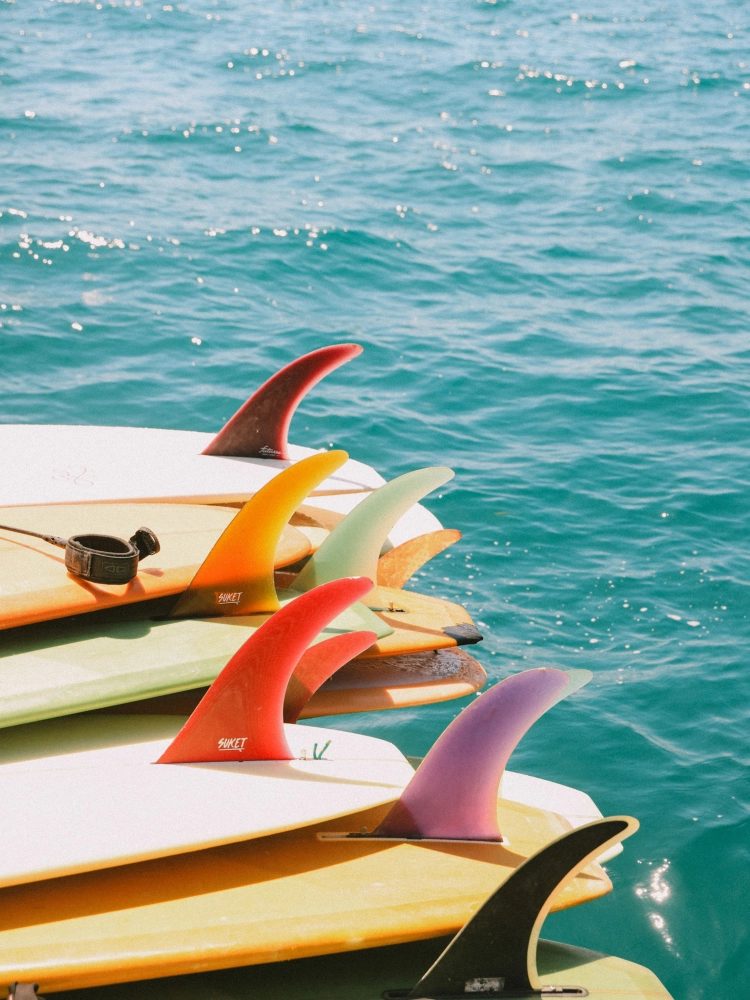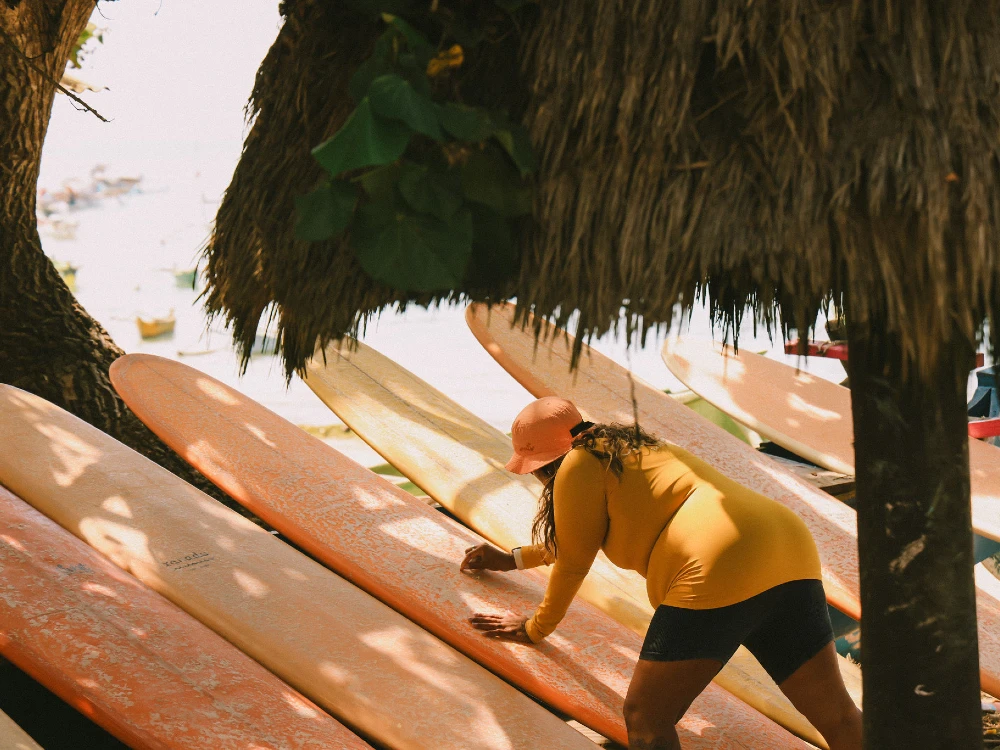Ever wondered what those tiny numbers are on the bottom or deck of a surfboard?
Maybe you’ve seen them before. Maybe you haven’t.
Either way, if you’re just learning to surf or you’re curious about why some boards perform differently than others, you’re bound to come across surfboard dimensions at one point.
Knowing what surfboard dimensions are and why they matter is an essential part of your learn-to-surf journey.
That said, the sheer amount of information around surfboards, surfboard design, volume measurement and dimensions can be overwhelming for novice surfers.
This guide is our way of cutting through the noise and giving you, as someone fresh to surfing or sizing up a new surfboard, an insight into what those numbers mean, their relevance and how to avoid getting lost in them.
Enjoy.


What are surfboard dimensions?
Surfboard dimensions are the measurements found written on a surfboard or listed online. The dimensions written on most surfboards include:
- Length: How long the board is from nose to tail
- Width: How wide the board is across its widest part
- Thickness: How thick the board is at its thickest part when viewed from the side
- Volume: How many litres of foam make up the board (aka volume measurement)
These numbers are generally shown in feet and inches or fractions. Volume, also called litreage, is shown in litres. It helps estimate how much float or bouyancy the board provides.
Why do they matter?
Surfboard dimensions (or “Dims” as they’re sometimes referred to) give you an overview of the size and shape of the board, which can impact how well it performs in the water.
For example, a board with dimensions of 8’ x 22” x 2.5” would be an 8-foot-long board that’s 22 inches wide at its widest part and 2.5 inches thick at its thickest part.
Add in a volume measurement (say 60 litres) and you can now estimate how much floatation it offers… which plays a big role in your ability to catch waves and stand with confidence.
By looking at the dimensions written on a board, you can generally tell if it’s suitable for your size, your skill level and the conditions you’re surfing in, like small waves or steeper surf.
Still, it’s important to remember that dimensions alone don’t tell the whole story.
Decoding surfboard litreage
One of the most prominent and often confusing features of a surfboard is its litreage.
This volume measurement refers to how much foam is inside the board and how well it helps you float.
Shortboards might sit at 25 to 35 litres, while beginner-friendly foamies and longboards can push to 40, 50 or even 60 plus litres. More volume means more floatation, which generally makes it easier to paddle, balance and catch waves… especially in smaller waves.
That said, volume is only part of the equation.
A board’s performance also comes down to how that foam is distributed, the tail shape, the rail profile and the overall design.
Two boards with the same volume can feel radically different depending on the rocker line, rail thickness and even the resin used in construction.
So yes, volume measurement matters. But what matters more is how it works in tandem with the shape of the board and how it suits your surfing style.
Myths and misconceptions around surfboard sizing
Let’s break down the most common myths we hear when surfers are trying to choose their next board.
These myths trip up a lot of beginners and even intermediates. People get caught up in the numbers written on a board, rather than how it actually feels in the water.
Here are the top 7 myths about surfboard dimensions and litres that might be holding you back from catching more waves.
MYTH 7: Length is everything
Let’s kill this one quickly.
A board’s length is just one piece of the puzzle.
Two boards that are both six feet long can ride like night and day. Why?
Because width, thickness and advanced design elements like rocker, tail shape, rail shape, foil and bottom contours all affect how a board actually feels.
Beginners often obsess over length, thinking shorter boards are the fast track to progress.
But that shortcut leads straight to frustration.
Want to level up?
Look at how the whole board is designed to move and not just from tip to tail.
MYTH 6: Small changes = huge differences
Do you agonise over a quarter inch here or there when picking your next board? Relax.
Unless you’re surfing at a high-performance level, small tweaks in length or thickness won’t make or break your session.
What matters more is how the board’s elements work together.
That includes how it distributes float through the thickest part of the board, how wide it is at the widest part and how that design helps you catch waves or link turns.
MYTH 5: Volume calculators know best
Volume calculators let you plug in your height, weight and experience level to suggest the ideal volume for a new surfboard.
They’re fine as a rough guide. But they can’t account for your paddle strength, your local wave size or your ability to read the ocean.
They don’t consider whether you’re surfing in small waves or punchy reef breaks.
Most importantly, they can’t feel what you feel.
You might need more volume than suggested or prefer the paddle speed of wider boards over narrow ones.
The only way to know is to try different boards and see what helps you float and catch waves best. So before you buy your first surfboard, consider booking a surfing holiday whereby you can try a range of different boards.
MYTH 4: Performance surfboards = faster progress
This one’s a classic mistake.
Many intermediate surfers believe that switching to a performance shortboard will magically boost their skills.
But shorter boards with less volume are harder to paddle, harder to float on and harder to catch waves with.
If you can’t catch waves, you can’t improve.
Choose a board that gives you more floatation, easier paddling and more time standing up so you can focus on your turns and your flow… not just staying upright.
MYTH 3: Bigger boards are only for beginners
Bigger boards aren’t just training wheels. They’re legit.
Our team still rides longboards, mid-lengths and wider boards when conditions call for it… especially in small waves or mellow surf.
Why? Because bigger boards make it easier to paddle out, get into position and catch waves early.
More volume means more floatation and more rides. And that often equals more fun.
MYTH 2: Every 8-foot surfboard feels the same
Not even close.
An 8-foot foamie, an 8-foot mini-Malibu and an 8-foot egg might all share the same length, but they won’t feel anything alike.
Their outlines, tail shapes, rails and bottom contours all change how they move through water.
Some will track straight and stable. Others will feel loose and skatey. It’s not just about size… it’s about design.
MYTH 1: You should always size down, not up
Too many surfers treat downsizing like a badge of honour. But smaller is not always better.
If you’re struggling to paddle, missing takeoffs or feeling wobbly once you stand, you probably need more volume, not less.
Sizing up gives you more floatation, more glide and a way higher chance of catching waves.
That doesn’t mean going back to a longer log, mind you.
It might just mean choosing a mid-length or wider board with a friendlier shape that suits your surfing better.
Surfboard dimensions FAQ
Q. What does volume actually mean on a surfboard?
Volume tells you how much space the board takes up and how well it floats. A higher volume board floats more, paddles easier and helps you catch waves.
Q. Should I choose a board based on my weight alone?
No. Your ability, fitness, local wave conditions and style all matter just as much. Two surfers with the same weight might need completely different boards.
Q. Do I need a shorter board to improve?
Not always. Sometimes a wider board or one with more volume is exactly what you need to catch more waves and build confidence.
Q. Is length the most important measurement?
No. Width, thickness, volume and tail shape all play a major role. Look at the whole board, not just how long it is.
Why do boards with the same dimensions ride differently?
Even if the numbers written on two boards are the same, they can feel very different. That’s due to design elements like rocker, foil, rail and even resin layup.
Need help choosing the right surfboard?
Whether you’re buying your first board or looking to upgrade, the right surfboard is the one that helps you catch waves and feel confident.
That’s it.
Don’t get too caught up in the dimensions written on the stringer. Think about how the board floats, how it fits your body, how it responds in your local conditions and how much fun you have riding it.
Still unsure?
Book a stay with Xanadu or chat to someone you trust in the lineup. Try different boards, play with shapes and be open to learning.
Because surfing isn’t about the numbers.
It’s about the feeling.




